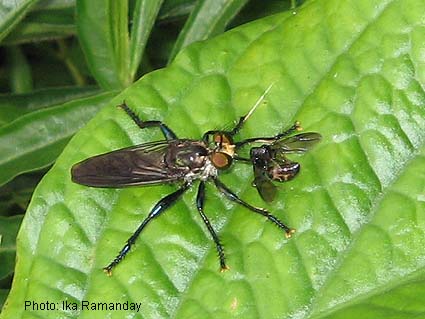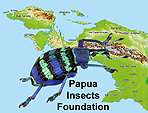

Papua-Insects.nl
The Papua Insects Foundation
The Diptera (crane flies, gnats, midges, mosquitoes and true flies) of Papua
(introduction by Herman de Jong)
The Diptera by their sheer number of species, diversity in immature and adult life strategies, and overwhelming variety in bodyforms and colourpatterns, are one of the largest and most important groups of insects. Annoying and irritating! is what most people think of the creatures of this insect order. However, many species play important and beneficial roles as pollinators of plants or cleaners of organic waste products like dead plants, dung, and dead animals. The most well known examples of harmful Diptera are the mosquitoes that spread malaria, black flies that transmit river blindness, and true flies that cause myiasis. Apart from that, many species can become a nuisance because of their ability to bite and suck blood or just because they can occur in high population densities.
The presented checklists are arranged by suborder and are mainly derived from the web version of the Catalog of the Diptera of the Australasian and Oceanian Regions (with kind permission of Neal L. Evenhuis), with the exception of the Tipuloidea which are provided by Pjotr Oosterbroek from his electronic Catalogue of the Craneflies of the world. The checklists for all families have been compiled recently and the authors are mentioned on the actual pages.
Represented suborders are: NEMATOCERA, BRACHYCERA and CYCLORRHAPHA
The Nematocera are in Papua represented by the superfamilies:
Tanyderoidea, Tipuloidea, Bibionoidea, Sciaroidea, Psychodoidea, Culicoidea, Chironomoidea
The Brachycera are in Papua represented by the superfamilies:
Tabanoidea, Stratiomyoidea, Asiloidea, Bombylioidea, Empidoidea
The Cyclorrapha are in Papua represented by the superfamilies:
Platypezoidea, Syrphoidea, Conopoidea, Nerioidea, Diopsoidea, Tephritoidea, Opomyzoidea, Sciomyzoidea, Lauxanioidea, Sphaeroceroidea, Ephydroidea, Muscoidea, Oestroidea, Hippoboscoidea